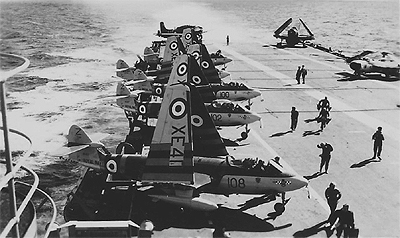
H.M.S. ALBION (R07)
OPERATION MUSKETEER 1956
As Remembered By Ray Clarke - 892 Sqdn Sea Venoms

A row of four Royal Navy Fleet Air Arm Hawker Sea Hawks FGA4
Fighter Jets of No. 800 Squadron on the deck of the Centaur Class Light Fleet Aircraft Carrier HMS Albion (R07/Deck letter Z) during the Suez Crisis in 1956. The characteristic yellow & black stripes carried by both the British & French aircraft are clearly visible on the rear of the aircraft on the roundel and under the folded wings. The nearest two Sea Hawk jets are XE411/108/Z and XE437/102/Z.
At the back of the flight deck are a pair of Douglas Skyraider AEW.1 aircraft of No. 849 Sqdn/C Flight and on the far Right a De Havilland Sea Venon FAW.21 of No. 809 Sqdn.
RP-3 (Rocket Projectile 3 inch) Rockets stored on the flight deck of the Centaur Class Light Fleet Aircraft Carrier HMS Albion (R07/ Deck letter Z) prior to being loaded/fitted onto the Hawker Sea Hawk jets of either No. 800 or No. 802 Squadron.
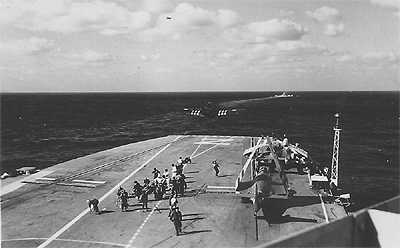
Royal Navy Fleet Air Arm Douglas AD-4W Skyraider AEW1 of C Flight
of
No. 849 Squadron taking off from the deck of HMS Albion during the Suez
Crisis of 1956. The yellow and black stripes carried by both the British &
the
French are clearly visible. Parked on the flight deck is a Hawker Sea Hawk
and a De Havilland Sea Venon of No. 809 Squadron.
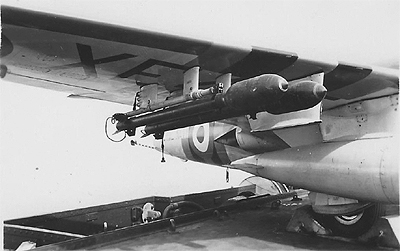
A pair of RP-3 (Rocket Projectile 3 inch) Rockets loaded under
the wing of
a Royal Navy Fleet Air Arm Hawker Sea Hawk FGA4/FGA6 of No. 800
Squadron on the deck of the Centaur Class Light Fleet Aircraft Carrier
HMS Albion (R07/Deck letter Z) during the Suez Crisis of 1956.
The characteristic yellow and black stripes of both the British & French
are clearly visible either side of the roundel.
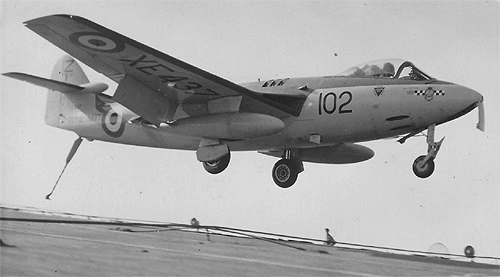
A Royal Navy Fleet Air Arm Hawker Sea Hawk FGA4 XE437 102/Z
of
No. 800 Squadron landing on the deck of the Centaur Class Light
Fleet Aircraft Carrier HMS Albion with its’ arrester hook hanging down.
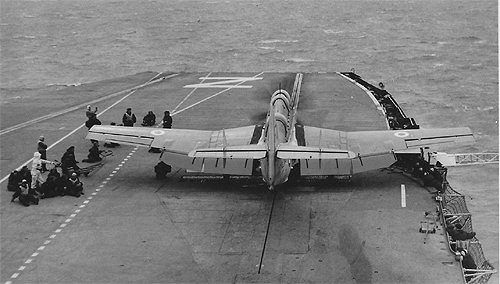
A visiting Royal Navy Fleet Airey Gannet Aircraft on the flight
deck of
the Centaur Class Light Fleet Aircraft Carrier HMS Albion
with possibly the code letters ‘FD’ on its’ tail
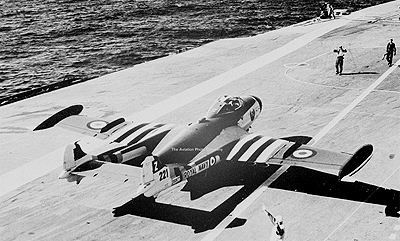
Royal Navy 809 Squadron De Havilland Sea Venon FAW21
XG677 on board HMS Albion, clearly showing the yellow &
black stripes of the British & the French
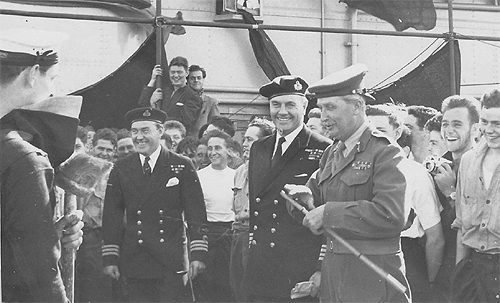
General Hugh Charles Stockwell, the British Army Commander of
Anglo-
French Ground Forces during the Suez Crisis of 1956 paying a visit to the
Centaur Class Light Fleet Aircraft Carrier HMS Albion (R07/Deck letter Z).
General Stockwell is wearing his cap back to front as he willingly
took part
in the Naval Tradition/Ceremony of ‘Marching Backwards to Christmas’
much to the merriment of the crew on board.
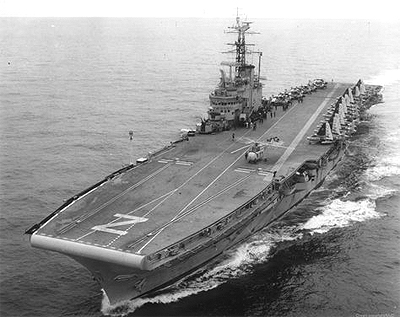
HMS Albion (R07)
This, the sixth Albion, was built by Swan Hunter & Wigham Richardson Ltd at Wallsend-on-Tyne as a Light Fleet Carrier of the ‘Centaur’ Class . Her keel was laid on the 23rd March 1944 and she was launched by the late Lady Atlee on the 6th May 1947. From then until 1949 the ship was berthed at Jarrow with only a care and maintenance party on board. Work on her resumed in August 1949 and sea trials began,
She had an overall length of 737 feet and a width of 123 feet 5 inches. Displacement about 26,000 tons.
On October 18th 1949 she was under tow by tugs Beamish, Hendon & George
V from Jarrow to Rosyth when Albion collided with SS Maystone 4 nautical miles
from Longstone Lighthouse. Maystone sank, Albion received a 225 square feet
hole in her stern and started to sink. The three tugs attempted to beach her
near St. Abbs Head but were hampered when Hector became disabled when a tow
rope wrapped around her propeller.
The tug HMS Restive was sent from Rosyth to assist and the destroyer HMS St.
James arrived and took Hector in tow until her crew managed to clear the propeller.
Albion was successfully berthed at Rosyth with 5 feet of water in her engine
room. She was scheduled for completion in 1951 but was not fully completed until
May 1954.
During the night of 19-20th June 1954, helicopters from Albion assisted in the search for survivors of a Swissair aircraft that had ditched in the English Channel off Folkestone, Kent.
She was the first British carrier to be fitted with both the “interim angled deck” of 5½ degrees to port and the mirror landing-sight device both on the port side of the flight deck and on the starboard side. The basic advantages of the angle-deck technique – the clear space ahead for overshoots and the increased parking space – are retained in this interim design, although only one of the two catapults can be used while landing is taking place. The full angle would, of course, give increased parking space, as well as permitting the operation of both catapults.
Of thirteen decks, four in the “island” contain the bridge, operations and wireless rooms, and the flying control position. The two decks immediately below the flight deck form the hangar, around and below which is the accommodation for 2041 officers and men. The lower decks house the boiler and engine-rooms, workshops, storerooms, magazines, furnace and aviation fuel tanks and a variety of machinery. Two lifts, which when in the “up” position form part of the flight deck, are used to carry aircraft, vehicles, guns, men and stores between the hangar and the flight deck. Another lift can bring a variety of explosives stores from the magazines or be used to convey stretcher cases from the flight deck to the sick bay.
Extensive radio equipment provides speech, Morse or tele-printer communications with other ships, aircraft and shore stations throughout the world. An automatic telephone exchange connects some 300 important spaces within the ship, while loudspeaker systems broadcast orders and informative talks as well as relaying radio and record programmes in off duty hours.
Space in any warship is at a premium and does not allow luxury accommodation for the men who man her. In Albion the mess decks are fitted with three-tiered bunks, some of which are stored away during the day to provide recreation spaces.
Four meals a day are served in the central dining rooms on a cafeteria system. Two different cinema programmes are normally shown each week when the ship is at sea, and television sets are hired by the Welfare Committee whilst in range of the UK transmitters. Amenities include a chapel, educational facilities, sick bay, canteen, barber’s shop, book stall, fiction and non-fiction libraries. An up-to-date laundry is operated by Chinese civilians whilst on the Far East station. All can participate in sports and games
In her first commission, Albion steamed over 83,000 miles during a two year period from May 1954.
In her second commission between June 1956 and November 1957, Albion returned once again to the Mediterranean Sea for operations relating to the Suez Crisis where her air group struck key Egyptian airfields, and covered the paratroopers landings. During this period her aircraft flew over 1,100 armed sorties.
After completion of her fourth commission as an aircraft carrier, Albion was taken in hand at HM Dockyard, Portsmouth for an extensive conversion. At completion of this she emerged as the Royal Navy’s second Commando Ship. This conversion embodied many of the feature found necessary from lessons learned in the first Commando Ship, HMS Bulwark. These included even more extensive air conditioning of living accommodation and working space. In her role as Commando Ship, Albion was modified to carry helicopters only. The equipment to operate conventional fixed wing aircraft such as Catapults and Arrester Wires were removed, but aircraft could, however, still land-on and take-off from the ship if necessary. Landing Craft were also carried to support the Commando in Assault and other military operations.
Albion was laid up in 1972 and was towed to Faslane for the ship breakers in
1973 after plans to use her in the North Sea oil fields were abandoned.
JUST REMINISCING
My story starts returning from the Far East on HMS Albion, back through the Canal in 1956. I was an armourer on 892 Squadron of Sea Venoms.
We returned to our base on HMS Heron, Yeovilton in Somerset. I met Joy, my wife to be, at a dance that took place at the Weslands Helicoptor Club on June 21st, 1956.
In July, the Squadron was recalled due to the Suez Crisis. We were billeted on HMS Falcon before embarking on HMS Eale, heading to Suez.
Joy and I kept in tough. I came home in 1957. In 1958 Joy and I were married and I was demobbed in May the same year.
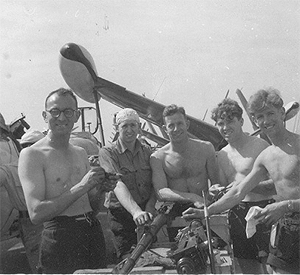
On the flight deck of HMS Albion coming through the Canal
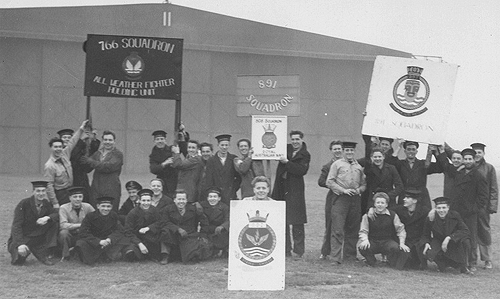
This was taken just before flying to Malta